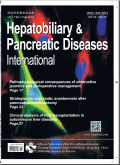- 钛学术文献服务平台 \
- 学术期刊 \
- 医药卫生期刊 \
- 内科学期刊 \
- 国际肝胆胰疾病杂志(英文版)期刊 \
null
Optimized liver resection range and perioperative safety in patients with high levels of indocyanine green R15
基本信息来源于合作网站,原文需代理用户跳转至来源网站获取
摘要:
To the Editor:
The indocyanine green (ICG) clearance test is an objective mea- surement of functional liver reserve (FLR) [1] . The liver can pre- serve normal functions with a 70% ? 80% functional liver volume resection [2] and the remnant is capable of regeneration. How- ever, liver regenerative properties are affected by hepatitis, fatty liver, cirrhosis and damage caused by chemotherapy [3] . ICG com- bined with the Child-Pugh score are main criteria for evaluating FLR. A safe hepatectomy procedure requires the remnant liver to be 25% ? 30% of the normal volume. For patients with an indo- cyanine green retention rate at 15 min (ICG-R15) > 20%, segment liver resection, limited hepatectomy or tumor enucleation is rec- ommended, but there has been no clear clarification of the essen- tial remnant liver volume [4] . In China, the experts' consensus of preoperative evaluation of liver reserve function incorporates ICG- R15 tests. R SE [essential functional liver volume (EFLV)/standard liver volume (SLV)] is introduced to evaluate the safety of hep- atectomy [5] . For patients with ICG-R15 levels between 20% and 30%, R SE = 80% and those with an ICG-R15 level range of 30% ? 40% or > 40%, safe surgeries like limited hepatectomy and tumorec- tomy are recommended [6] . There is a paucity of studies that focus on surgical safety for patients with an ICG-R15 > 20%. Herein we aimed to evaluate safe liver resections in these patients.

推荐文章
期刊_丙丁烷TDLAS测量系统的吸收峰自动检测
带间级联激光器
调谐半导体激光吸收光谱
雾剂检漏 中红外吸收峰 洛伦兹光谱线型
不同盐度、温度及光照对漂浮浒苔生理生态的影响
浒苔
盐度
温度
光照
生理生态
期刊_联合空间信息的改进低秩稀疏矩阵分解的高光谱异常目标检测
高光谱图像
异常目标检测 低秩稀疏矩阵分解 稀疏矩阵 残差矩阵
内容分析
关键词云
关键词热度
相关文献总数
(/次)
(/年)
文献信息
| 篇名 | Optimized liver resection range and perioperative safety in patients with high levels of indocyanine green R15 | ||
| 来源期刊 | 国际肝胆胰疾病杂志(英文版) | 学科 | |
| 关键词 | |||
| 年,卷(期) | 2020,(5) | 所属期刊栏目 | |
| 研究方向 | 页码范围 | 495-498 | |
| 页数 | 4页 | 分类号 | |
| 字数 | 语种 | 英文 | |
| DOI | |||
五维指标
引文网络
引文网络
二级参考文献 (25)
共引文献 (13)
参考文献 (6)
节点文献
引证文献 (0)
同被引文献 (0)
二级引证文献 (0)
1900(1)
- 参考文献(0)
- 二级参考文献(1)
1973(1)
- 参考文献(0)
- 二级参考文献(1)
1995(1)
- 参考文献(0)
- 二级参考文献(1)
1997(1)
- 参考文献(1)
- 二级参考文献(0)
2000(1)
- 参考文献(1)
- 二级参考文献(0)
2004(1)
- 参考文献(0)
- 二级参考文献(1)
2005(3)
- 参考文献(1)
- 二级参考文献(2)
2006(1)
- 参考文献(0)
- 二级参考文献(1)
2008(2)
- 参考文献(1)
- 二级参考文献(1)
2010(2)
- 参考文献(0)
- 二级参考文献(2)
2011(3)
- 参考文献(0)
- 二级参考文献(3)
2013(4)
- 参考文献(1)
- 二级参考文献(3)
2014(2)
- 参考文献(0)
- 二级参考文献(2)
2015(1)
- 参考文献(0)
- 二级参考文献(1)
2016(2)
- 参考文献(0)
- 二级参考文献(2)
2017(3)
- 参考文献(0)
- 二级参考文献(3)
2018(1)
- 参考文献(0)
- 二级参考文献(1)
2019(1)
- 参考文献(1)
- 二级参考文献(0)
2020(0)
- 参考文献(0)
- 二级参考文献(0)
- 引证文献(0)
- 二级引证文献(0)
引文网络交叉学科
相关学者/机构
期刊影响力
国际肝胆胰疾病杂志(英文版)
主办单位:
浙江大学医学院第一附属医院
出版周期:
双月刊
ISSN:
1499-3872
CN:
33-1391/R
开本:
大16开
出版地:
浙江省杭州市庆春路79号
邮发代号:
创刊时间:
2002
语种:
eng
出版文献量(篇)
1879
总下载数(次)
0
期刊文献
相关文献
推荐文献
- 期刊分类
- 期刊(年)
- 期刊(期)
- 期刊推荐
国际肝胆胰疾病杂志(英文版)2022
国际肝胆胰疾病杂志(英文版)2021
国际肝胆胰疾病杂志(英文版)2020
国际肝胆胰疾病杂志(英文版)2019
国际肝胆胰疾病杂志(英文版)2018
国际肝胆胰疾病杂志(英文版)2017
国际肝胆胰疾病杂志(英文版)2016
国际肝胆胰疾病杂志(英文版)2015
国际肝胆胰疾病杂志(英文版)2014
国际肝胆胰疾病杂志(英文版)2013
国际肝胆胰疾病杂志(英文版)2012
国际肝胆胰疾病杂志(英文版)2011
国际肝胆胰疾病杂志(英文版)2010
国际肝胆胰疾病杂志(英文版)2009
国际肝胆胰疾病杂志(英文版)2008
国际肝胆胰疾病杂志(英文版)2007
国际肝胆胰疾病杂志(英文版)2006
国际肝胆胰疾病杂志(英文版)2020年第6期
国际肝胆胰疾病杂志(英文版)2020年第5期
国际肝胆胰疾病杂志(英文版)2020年第4期
国际肝胆胰疾病杂志(英文版)2020年第3期
国际肝胆胰疾病杂志(英文版)2020年第2期
国际肝胆胰疾病杂志(英文版)2020年第1期

 免费查重
免费查重










